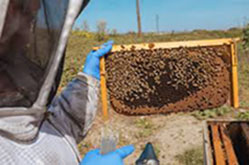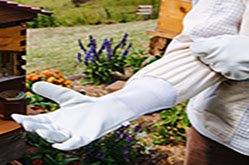Six Highly Preferred Beekeeping Gloves Types

4 Finest Flowers to Keep the Bees Buzzing In Your Garden
October 13, 2020
Importance of Wearing Beekeeping Gloves
December 14, 2020Bees are vital for our ecosystem and the survival of agriculture. These small creatures produce honey, pollinate for the plants to spread and grow, breed, and produce food. As a fact, one-third of the global food supply is pollinated by bees. Humans and animals will simply cease to exist.
Since the birth of multiple awareness campaigns to save bees, the practice of beekeeping has increased both locally and commercially. Beekeeping is an amazing hobby and business but the occupation must be practiced with few safety measures regardless of the expertise level.
Even in the 21st century, with all the technology and advanced accessories, you will witness individuals handling the bees bare hand dressed in casual clothes.
Such individuals are usually tending the docile bees where the probability of sting is very low. It’s brave but practical because even the docile bee will sting guarding their homes and queen.
Two of the most important beekeeping protective gear/ accessories include beekeeping gloves paired with beekeeping veils. While the beekeeping veils are not required to be manufactured in varieties but gloves for beekeeping are manufactured in different types, features, and sizes making it hard to choose among so many options.
Top-notch Beekeeping Gloves to Ensure Safety:
Each manufacturer advertises its product in a different manner. Each type of gloves comes with certain essential qualities and properties to suit your comfort.
Leather Beekeeping Gloves with Cotton Sleeves:
Experts performing extensive beekeeping work look for comfort in the gloves. Leather beekeeping gloves with cotton sleeves are one of the most durable, resilient, light touch, and comfortable gloves.
The upper part of the gloves or the area covering your palms and wrist is made from leather whereas the sleeves are made of thick cotton. The gloves ensure protection with an elastic closure and come with a circumference of about 7 inches to fit any standard arm size.
Despite the fact that the gloves are made from two different materials, these still provide maximum protection from bee stings excluding African bees.
Ventilated Beekeeping Gloves:
The ventilated beekeeping gloves come in leather, cowhide, and goatskin varieties. These gloves are extra-long providing protection all the way to the elbow. It offers knuckle size up to 16cm standard measurement.
Ventilated beekeeping gloves are preferred in the bee active seasons of summer and spring. The ventilation exists above the wrist to keep the hands cool and from sweating in the scorching heat or humidity. Cowhide and goatskin ventilated gloves are soft and durable materials yet thick enough to ensure safety while beekeeping.
Goat-skin Leather Beekeeping Gloves:
The goatskin leather has properties including durability, stretchable, softness, thickness, smooth grains, and lightweight. Goatskin beekeeping gloves are preferred because of the extra room inside it provides for the fingers. The goatskin beekeeping gloves are designed to include string proof cuffed and elasticated gauntlet design.
Cowhide Leather Beekeeping Gloves:
Cowhide leather beekeeping gloves are often in comparison or in competition with the goatskin leather gloves. Both gloves in fact come with ensuring protection from the bee stings, and the purchase is widely based on personal preferences.
Cowhide beekeeping gloves are thicker in nature but provide a tailored fit and tensile strength. Cowhide leather provides comparable extensive durability than other gloves due to its natural abrasion resistance.
Ventilation and Cuff Fit Bee Keeping Gloves:
The currently manufactured gloves come with ventilation and cuff properties. The breathable material is perfect for warm weather. It ventilates air and temperature on the skin hand while providing a good grip and easy to carry the bees without hurting them. The cuff provides you protection against the bee sting and bee invade inside the suit.
Despite the thick material, it provides flexibility in performing delicate tasks and also protects your hand from shifting the hives.
Snug Fit Beekeeping Gloves:
Beekeeping gloves should be absolutely snug fit no matter what material you are choosing. Today most of the gloves manufactured fabric are bee sting resistant but the fit is important.
A snug fit will prevent any bees from getting inside of your suit and especially your wrist. Few stings on your wrist can prove to be fatal because they sting your veins very easily and it is more painful as well.
Another reason for snug fit is the folds in the gloves. A loose glove will have several folds and the bees can get stuck in these folds and you wouldn’t even notice. At the end of the day, you will be bringing bees inside of your house and as a response to danger, the bee might be anyone in the house.
Fitted gloves mean fewer folds and fewer folds mean no bees in the house or inside the suit.
Why is the right pick important?
Preventing stings and keeping the bees safe is the primary purpose of the beekeeping gloves but there are also other benefits for it. A top-notch beekeeping pair of gloves help maintain dexterity, keep comb intact, and eliminate hiding places or extra risks. With a good pair, you will also feel confident beekeeping.




